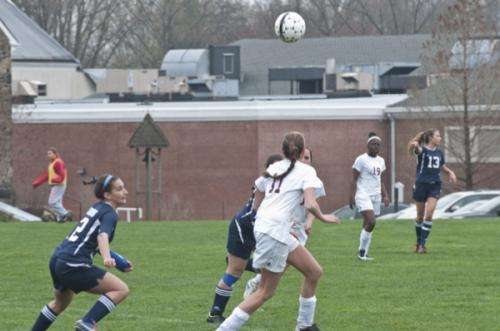Research examines effect of heading in previously concussed female soccer players

(Medical Xpress)—A goal in soccer is worth one point no matter how it's scored, but for fans there may be no greater thrill than watching a talented player head the ball into the net.
But fan fun aside, how does heading the ball affect players, especially children whose brains are still developing?
"Heading is such an integral part of the game that I think it's important for us to know whether or not it's actually dangerous based on scientific data rather than anecdotal evidence," says Tom Kaminski, professor in the Department of Kinesiology and Applied Physiology at the University of Delaware.
Ten years ago, Kaminski began to document heading exposures in both collegiate and high school female soccer players. With a battery of neuropsychological and balance tests administered both before and after the soccer season, he found that heading did not affect short-term neurocognitive function in this pool of athletes.
But is the same true for young women who have already sustained concussions?
Neuroscience major Cameron Forbes was interested in this question as a topic for his senior thesis, and Kaminski's database proved to be a perfect source of information for him.
Advised by Kaminski and Joseph Glutting, professor in UD's School of Education, Forbes conducted a study to examine neurocognitive function in previously concussed female soccer players.
"Surprisingly, we found no difference between the experimental group and the control subjects," Forbes says. "Our work suggests that although previously concussed subjects engage in purposeful heading throughout a competitive season, they do not appear to be at additional risk for a decline in neuropsychological function or a return of concussion symptoms."
"More research is needed to assess the effects over the course of an entire playing career," he adds. "Also, our study was done on nonprofessional female players, where the speed of the ball is relatively low—maybe 25 miles per hour. In contrast, ball speeds in excess of 70 miles per hour have been recorded at the professional level with male players, so the results could be different with that population."
Both Forbes and Kaminski are well aware that many questions remain to be answered about the effects of ball heading, but the still-growing database will serve as a valuable resource for those who want to examine other aspects of the issue.
"I've always been interested in sports and exercise, so this project was a perfect fit for me as a neuroscience major," Forbes says. "Dr. Kaminski was very open to working with me, and he was great about letting me pave my own path with the work."
Kaminski refers to Forbes as "a tremendous asset."
"I view him the way I view my grad students," he says, "and he has brought valuable knowledge about neuroscience to this work. He's also setting an example for other undergraduates that even if they're based in a different department or college, there are opportunities here at UD and experts to support them as they pursue those opportunities."
A paper documenting the research, with Forbes as the lead author, is under review by the Journal of Sports Sciences, and the abstract was among just ten chosen for a special session at the American College of Sports Medicine's 60th annual meeting in May 2013.
In addition, an abstract by doctoral student Alan Needle, Kaminski, and associate professor Buz Swanik was one of ten selected for another special session at the same conference.
"For two UD students' abstracts to be among 20 chosen out of more than 2,700 abstracts is amazing," Kaminski says. "This recognition speaks volumes about not only the research we're doing but also the quality of our students at both the undergrad and graduate levels."


















